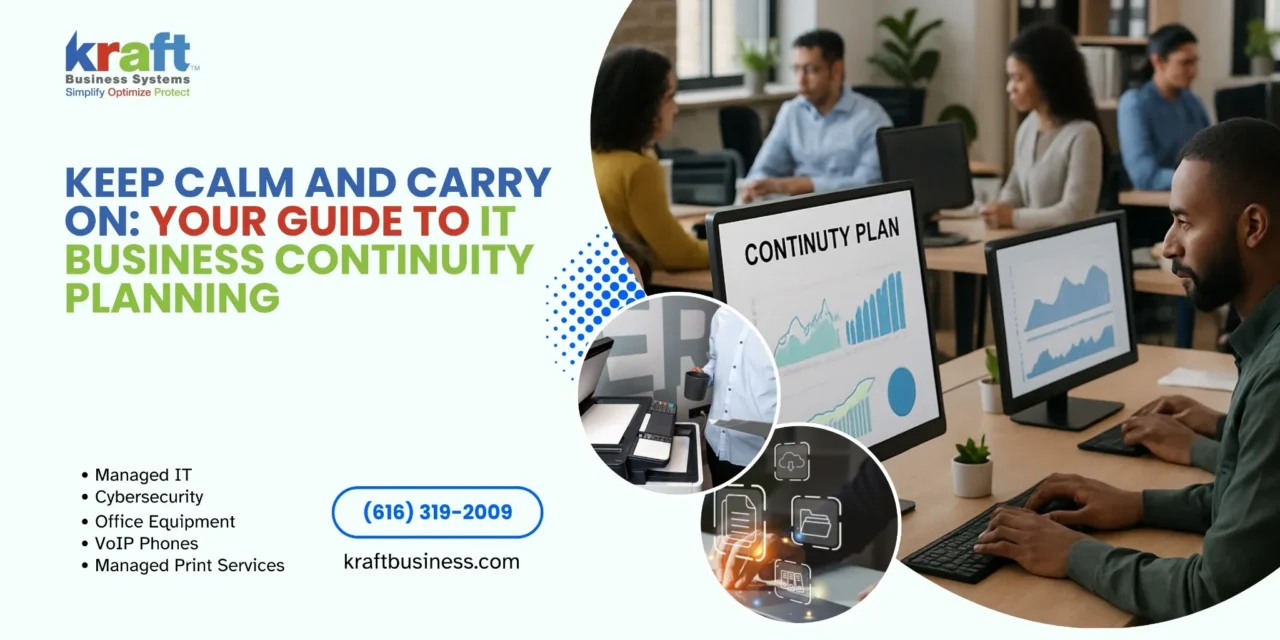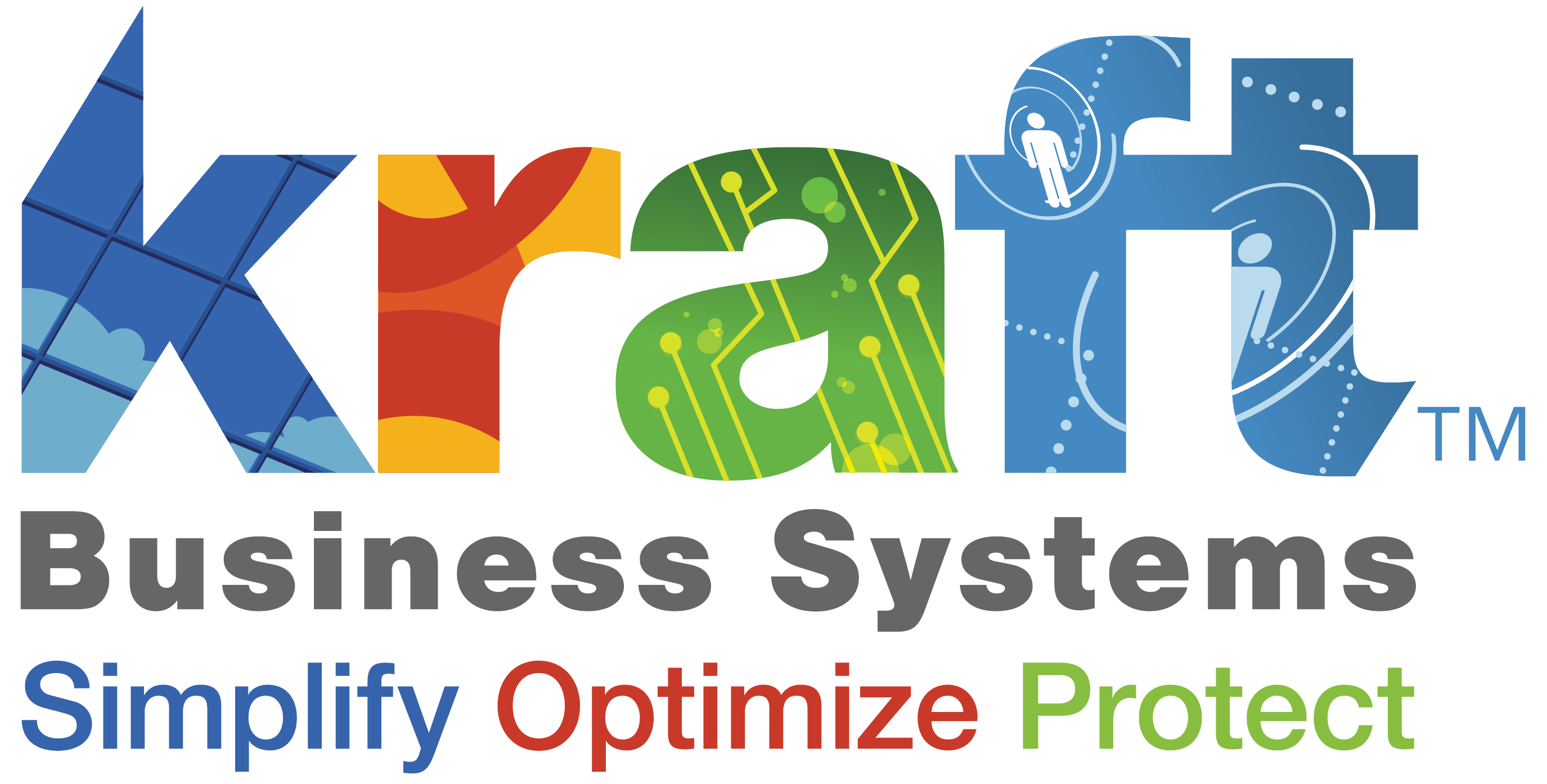Business continuity planning IT is a structured approach to ensuring critical technology systems and business operations can continue during and after a disruption. It focuses on maintaining essential functions, protecting data, and minimizing downtime.
For busy business owners seeking quick understanding:
| Business Continuity Planning IT: Key Components |
|---|
| 1. Risk assessment & business impact analysis |
| 2. Recovery time objectives (RTO) & recovery point objectives (RPO) |
| 3. Backup & recovery strategies |
| 4. Alternative worksites & remote work capabilities |
| 5. Testing, training & plan maintenance |
When disaster strikes, preparation makes all the difference. According to PwC research, 96% of business leaders experienced significant disruption in the past two years, yet only 70% felt confident in their organization’s ability to respond effectively. Whether facing cyberattacks, power outages, natural disasters, or human error, your business needs a roadmap to recovery.
Think of business continuity planning as your organization’s insurance policy against the unexpected. It’s not just about IT systems – it’s about people, processes, and technology working together to maintain operations when things go wrong.
“Every tabletop exercise that I’ve ever done has been an eye-opener for everyone involved,” notes one expert cited in our research. These simple tests often reveal critical gaps in planning that could mean the difference between quick recovery and prolonged downtime.
The stakes are high. Downtime costs money, damages reputation, and can even threaten your company’s survival. But with proper planning, you can transform potential disasters into manageable incidents.
A comprehensive IT business continuity plan does more than protect technology – it safeguards your entire business ecosystem and gives you peace of mind knowing you’re prepared for whatever comes your way.
Business Continuity Planning IT: What It Really Means
Business continuity planning IT is so much more than just backing up your data. It’s your organization’s comprehensive playbook for keeping the lights on when disaster strikes.
Definition and Scope
Think of a business continuity plan as your organization’s North Star during chaotic times. It’s that detailed roadmap that guides you through disruptions, whether small or catastrophic. Many folks mistake it for simple disaster recovery, but it reaches far beyond that.
Business continuity planning wraps its arms around your entire operation:
- It’s about your people and their workflows, not just servers and software
- It considers your whole business ecosystem, including vendors and partners
- It emphasizes prevention, not just reaction
- It manages risks comprehensively
- It builds lasting operational resilience
Here at Kraft Business Systems, we’ve seen from our work with businesses across Michigan that technology is just one piece of the continuity puzzle – though admittedly, a crucial one!
BCP vs. DRP vs. Business Resilience
These terms often get tossed around interchangeably at meetings, but they’re actually distinct approaches to preparedness:
| Aspect | Business Continuity Plan | Disaster Recovery Plan | Business Resilience |
|---|---|---|---|
| Focus | Entire business operation | IT systems and data | Organizational adaptability |
| Scope | Comprehensive | Technical | Strategic |
| Timeframe | Before, during, and after disruption | After disruption | Continuous |
| Goal | Maintain critical functions | Restore IT systems | Build adaptive capacity |
| Ownership | Cross-functional | IT department | Enterprise-wide |
Think of business resilience as your organization’s immune system – always on alert, ready to respond to whatever comes your way. Meanwhile, business continuity planning IT provides the specific playbook for how to handle particular scenarios when they arise.
For a deeper dive into how these concepts work together, check out our guide on Business Continuity and Disaster Recovery: Is Your Business Ready?
Key Technical Concepts: RTO and RPO
When we sit down with clients to develop their business continuity planning IT strategy, two critical numbers always drive the conversation:
- Recovery Time Objective (RTO): How long can you afford to be without this system? Your email might need to be back up within 4 hours, while your accounting system might tolerate a full day of downtime.
- Recovery Point Objective (RPO): How much data can you afford to lose? An RPO of 1 hour means you need backups that ensure you’ll never lose more than an hour’s worth of information.
These aren’t arbitrary numbers – they’re carefully calculated values that help prioritize your recovery efforts and determine exactly what backup strategies make sense for different systems.
The Business Continuity Planning IT Lifecycle
Creating a business continuity planning IT strategy isn’t a one-and-done project. It’s a living process that follows a continuous cycle:
- Initiation: Getting leadership buy-in, defining what’s in scope, and building your planning team
- Risk Assessment: Identifying what could possibly go wrong with your IT systems
- Business Impact Analysis (BIA): Determining which functions are absolutely critical and what happens if they’re disrupted
- Strategy Design: Creating practical recovery approaches for different scenarios
- Implementation: Documenting step-by-step procedures and making sure resources are available
- Testing: Running simulations to make sure the plan actually works
- Maintenance: Regularly dusting off the plan and updating it as your business evolves
This cycle never truly ends. As your business grows, technologies change, and new threats emerge, your business continuity planning IT strategy needs to evolve right alongside them.
Why a Robust Plan Matters for Your Tech Stack
Your business runs on technology, and when that technology fails, everything grinds to a halt. A robust business continuity planning IT strategy isn’t just a nice-to-have—it’s essential for survival in our interconnected world.
The High Cost of Downtime
When systems go down, money flies out the window. The financial impact hits from multiple angles:
Your revenue stream dries up as sales and services screech to a halt. Your team sits idle, unable to do their jobs while still collecting paychecks. Then come the recovery costs—sometimes astronomical—to get everything back up and running.
For businesses across Michigan, from manufacturing powerhouses in Detroit to service companies here in Grand Rapids, even a few hours offline can translate to thousands or even millions in losses. And that’s before we talk about potential regulatory fines or the customer trust you might never fully rebuild.
The Growing Threat Landscape
The dangers lurking around your tech stack have never been more numerous or sophisticated. Ransomware attacks now strike every 11 seconds on average, with typical payments exceeding $230,000—a potentially devastating blow to a mid-sized Michigan business.
Mother Nature doesn’t help either. From severe flooding to the brutal winter storms we know all too well in Michigan, natural disasters pose very real threats to your physical infrastructure. And let’s not forget that despite our best security systems, human error remains one of the leading causes of system failures and data breaches.
Supply chains have grown increasingly fragile too. When you can’t get replacement hardware or critical software updates, your entire operation feels the pinch. And those Michigan power outages during ice storms? They don’t discriminate between home and business users.
Regulatory Pressure and Compliance
Many of our clients face stringent regulatory requirements around data protection and system availability. Healthcare organizations must steer HIPAA’s complex maze. Financial institutions have GLBA to contend with. Manufacturers face their own industry standards.
Breaking these rules doesn’t just mean potential fines—it can mean lost business opportunities or even, in highly regulated sectors, losing your license to operate altogether. Your business continuity planning IT strategy needs to account for these compliance requirements from the ground up.
The Remote Work Revolution
Remember when everyone worked in the same building? Those days are gone. Your continuity plan now needs to consider a workforce scattered across Michigan—or beyond.
This distributed model creates new challenges: home internet connections that fail, power outages affecting individual employees rather than your whole operation, personal devices with varying security levels, and heightened dependence on cloud services.
At Kraft Business Systems, we’ve helped countless Michigan businesses adapt to this new reality. We understand that resilience now means ensuring productivity regardless of where your team members are physically located or what unexpected challenges arise.
Our Managed Cybersecurity Services: Backup and Disaster Recovery solutions are specifically designed to protect your business in this evolving landscape, giving you peace of mind that your operations can continue even when the unexpected happens.
Building Your IT Business Continuity Plan Step-by-Step
Creating an effective business continuity planning IT strategy doesn’t have to feel like climbing Mount Everest. Let’s break it down into manageable steps that any Michigan business can follow.
Step 1: Establish Governance and Assign Responsibilities
Every successful plan needs clear ownership. Your continuity planning team should include faces from across your organization:
An executive sponsor who champions the cause (usually someone from the C-suite), a dedicated BCP coordinator who keeps everything on track, representatives from different departments who understand their areas, technical experts who know your systems inside and out, and sometimes external partners who bring specialized knowledge.
Small businesses in Michigan don’t need to panic if they’re short-staffed. That’s where we at Kraft Business Systems come in – we’re happy to fill those knowledge gaps and guide you through the entire process.
Step 2: Conduct a Business Impact Analysis
Think of a Business Impact Analysis (BIA) as your business’s priority list during a crisis. This critical step helps you identify what absolutely must keep running and what can wait.
Your BIA should map out your key business processes and the IT resources they depend on. It needs to answer tough questions like “What happens if this system is down for a day? A week?” Then establish clear recovery timeframes for each system.
Need a starting point? The Business Impact Analysis Worksheet from Ready.gov is a fantastic template to get you going.
Step 3: Create a Critical Systems Inventory
You can’t protect what you don’t know you have. Create a comprehensive inventory of everything that keeps your business running: the hardware humming in your server room, the software your team relies on daily, your precious data assets, the services you’ve subscribed to, and all the documentation that explains how it all works together.
For each item, note its recovery priority (based on your BIA), what other systems it depends on, how you’ll recover it if something goes wrong, and who to call for help. This inventory becomes your technology roadmap during a crisis.
Step 4: Develop Recovery Strategies
Now comes the “how” of getting back to business. Your recovery strategies should match the priorities you identified in your BIA:
For your data, implement robust backup solutions with appropriate retention periods. Identify alternative locations where your team can work if your main office becomes unavailable. Consider cloud failover options for critical applications that can’t afford downtime. Keep spare equipment on hand for quick replacement of essential hardware. And don’t forget to document manual workarounds for continuing operations when technology fails you.
Not every system needs the same level of protection. Your strategy should balance cost with risk reduction in a way that makes sense for your business.
Step 5: Create Communication and Notification Plans
When disaster strikes, clear communication becomes your lifeline. Your plan should include up-to-date contact information for everyone involved, clear procedures for who contacts whom and when, multiple communication channels in case primary methods fail, pre-written message templates for various scenarios, and guidelines for communicating with customers, vendors, and the media.
Your usual email or phone systems might be unavailable during a crisis. Plan for alternative ways to stay connected when normal channels go down.
Step 6: Document and Implement the Plan
Finally, bring all these elements together into a comprehensive business continuity planning IT document. The best plans are accessible in both digital and physical formats (stored in multiple locations), written in plain language with clear step-by-step instructions, specific enough to guide actions during stressful situations, and focused on essential information without unnecessary fluff.
The Business Continuity Plan template from Ready.gov provides an excellent foundation that you can customize for your organization’s specific needs.
Essential Tools for Business Continuity Planning IT
The right tools can make your planning and implementation process much smoother. Consider investing in dedicated BCP software for developing and managing your plans, documentation tools for maintaining and sharing plan documents, automation tools that can trigger recovery processes without human intervention, monitoring systems that alert you to potential problems before they become disasters, and cloud orchestration tools that manage failover to cloud environments.
Here at Kraft Business Systems, we help businesses across Michigan select and implement the right tools based on their specific needs and budget. We understand that every organization is unique, and we’re committed to finding solutions that work for you—not just selling you a one-size-fits-all package.
Learn more about our approach to Data Backup and Recovery to see how we can help protect your critical information.
Testing, Training, and Continuous Improvement
A business continuity plan that just sits in a drawer won’t save your business when disaster strikes. Think of your plan like a muscle – it needs regular exercise to perform when you need it most.
Types of Tests and Exercises
At Kraft Business Systems, we’ve seen that organizations with well-tested plans recover faster when real emergencies happen. Here’s how you can put your business continuity planning IT through its paces:
Tabletop exercises are conversation-based walkthroughs where your team discusses how they’d respond to various scenarios. These low-stress sessions are perfect starting points, allowing team members to talk through their responsibilities without disrupting operations.
“Every tabletop exercise I’ve facilitated has revealed at least one critical gap nobody anticipated,” shares one of our continuity planning specialists. “It’s much better to find those gaps during practice than during a real crisis.”
Structured walkthroughs dig deeper into specific components of your plan, while functional exercises simulate disruptions to particular systems without affecting your entire operation.
For the most comprehensive preparation, full-scale simulations mimic actual disruptions as realistically as possible. Meanwhile, technical testing verifies specific recovery capabilities like restoring systems from backups or activating redundant infrastructure.
Most of our Michigan clients test their plans quarterly, alternating between simpler tabletop exercises and more complex simulations.
The “Fresh Eyes” Approach
Sometimes the people who create plans develop blind spots. Bringing in team members who weren’t involved in developing your business continuity planning IT strategy can reveal assumptions and gaps that insiders might miss.
Consider including new employees who bring perspectives from previous employers, staff from different departments who might spot cross-functional issues, or even trusted vendors who understand how external dependencies might affect your recovery.
One of our Grand Rapids manufacturing clients finded a critical gap in their plan when a newly-hired warehouse manager pointed out that their recovery strategy didn’t account for temperature-sensitive inventory during power outages. This simple observation potentially saved them thousands in spoilage costs.
Measuring Plan Effectiveness
How do you know if your plan is working? Set clear metrics to evaluate performance during tests:
Recovery time measures how quickly you can restore critical systems. Are you meeting your RTOs? Data loss quantifies how much information disappeared during the incident – does this align with your RPOs?
Process compliance tracks whether team members followed documented procedures or improvised (which might indicate your plan needs updating). Communication effectiveness assesses how well information flowed between teams, while resource utilization confirms whether you allocated sufficient people, equipment, and budget.
These measurements help transform testing from a checkbox exercise into a genuine learning opportunity.
Creating a Culture of Continuity Awareness
Your business continuity planning IT efforts will be far more effective when preparedness becomes part of your company culture.
Make continuity training part of your onboarding process so new employees understand their roles from day one. Schedule regular refreshers for existing staff, particularly after plan updates. Consider creating simple reference cards employees can keep at their desks with key contact information and immediate response steps.
Executive support is crucial – when leadership demonstrates commitment to preparedness, employees follow suit. One of our healthcare clients in Ann Arbor makes this visible by having their CEO participate in every annual full-scale test.
Maintenance and Updates
Your business evolves constantly, and your continuity plan needs to keep pace. A plan that protected you perfectly last year might have dangerous gaps today if it hasn’t been maintained.
Schedule formal reviews at least annually, but also update your plan after:
- Implementing new systems or applications
- Changing critical business processes
- Restructuring your organization
- Moving to new facilities
- Experiencing actual disruptions (incorporate lessons learned)
- Noticing gaps during testing
We recommend appointing a specific person or team responsible for maintaining your plan’s accuracy. At Kraft Business Systems, we help many Michigan businesses establish manageable maintenance schedules that keep plans current without becoming burdensome.
For more detailed guidance on testing and maintaining your recovery strategy, check out our guide to IT Disaster Recovery Planning.
The goal isn’t perfection – it’s continuous improvement. Each test, each update, each lesson learned makes your business more resilient and better prepared for whatever challenges tomorrow brings.
Future Trends and Best Practices in Business Continuity
The world of business continuity planning IT isn’t standing still. Like your business, it’s constantly evolving to meet new challenges and accept new technologies. Let’s explore what’s on the horizon and how you can stay ahead of the curve.
Cloud-Native Continuity Solutions
Remember when disaster recovery meant shipping backup tapes to an offsite location? Those days are thankfully behind us. Cloud technologies have transformed how we approach business continuity:
Businesses across Michigan are finding that cloud solutions offer enterprise-grade protection without enterprise-level price tags. Your data can now be automatically replicated across multiple regions, giving you peace of mind that even regional disasters won’t take you offline for long.
“Infrastructure as Code” might sound like technical jargon, but it’s a game-changer for recovery. It means your entire system configuration can be deployed rapidly after a disruption—no more manual rebuilding of servers and applications.
Containerization and serverless architectures are making recovery even simpler by creating portable environments that can run virtually anywhere. And with SaaS applications, much of the continuity burden shifts to your providers, who typically offer robust redundancy.
AI and Predictive Analytics
Artificial intelligence isn’t just for chatbots and virtual assistants—it’s becoming a powerful ally in business continuity planning IT:
AI systems can now spot potential problems before they become disasters, giving you valuable time to prepare. Imagine getting an alert that your server is showing early signs of failure, allowing you to migrate workloads before it crashes.
The most exciting development might be automated response capabilities. When seconds count, AI can trigger recovery processes instantly—no human intervention required. These systems can also run complex simulations to help you identify weak points in your continuity strategy.
While these technologies are still maturing, they’re increasingly accessible to businesses of all sizes. At Kraft Business Systems, we’re helping Michigan organizations incorporate these capabilities into their continuity planning.
Zero-Trust Security Models
Security and continuity planning have become inseparable. The zero-trust approach is particularly valuable when thinking about recovery:
Assume breach has become the watchword of modern security. Your continuity plan should anticipate that security compromises will happen and include specific recovery steps for these scenarios.
During recovery operations, when teams are focused on restoring services quickly, security can sometimes take a backseat. Zero-trust principles like least privilege and continuous verification help maintain your security posture even during crisis response.
System segmentation is another powerful strategy that serves both security and continuity goals. By isolating systems from each other, you can contain impacts and enable partial recovery while addressing specific problems.
Hybrid Workforce Considerations
The pandemic changed how we work, and business continuity planning IT has had to evolve accordingly. When your team is distributed across home offices and coworking spaces, your continuity strategy needs to reflect this reality:
Remote recovery teams need robust coordination tools and clear protocols. We’ve helped many Michigan businesses develop communication plans that work even when team members are miles apart.
Home office continuity has become a critical consideration. For key personnel, this might mean providing backup power solutions, redundant internet connections, or even alternative workspaces they can access if their homes are affected.
BYOD (Bring Your Own Device) policies need careful consideration in your continuity planning. Can employees effectively perform critical functions on their personal devices if company equipment is unavailable? What security measures need to be in place?
Cloud workspace solutions like virtual desktops offer a powerful recovery option, allowing employees to access their work environment from virtually any device with internet access.
Supply Chain Visibility and Resilience
Your business doesn’t exist in isolation, and neither should your continuity planning. Modern business continuity planning IT increasingly addresses the complex web of dependencies that keep your business running:
Vendor assessment has become a crucial component of continuity planning. Do your critical suppliers have robust continuity plans of their own? What happens to your operations if they experience a prolonged outage?
Multi-sourcing strategies help avoid single points of failure. While maintaining relationships with multiple vendors for critical supplies might seem inefficient in normal times, it can be a lifesaver during disruptions.
Contract provisions around continuity can provide important protections. We recommend including specific continuity requirements in agreements with key technology vendors.
This supply chain focus is especially important for manufacturing businesses across Michigan’s industrial centers, where just-in-time delivery models leave little room for disruption.
Best Practices for Modern Continuity Planning
Based on our experience serving businesses throughout Michigan, here are the practices that separate resilient organizations from vulnerable ones:
Executive ownership makes all the difference. When continuity planning has C-level sponsorship, it gets the attention and resources it deserves. Without it, plans often gather dust until disaster strikes.
Cross-functional involvement ensures your plan addresses the whole business, not just IT systems. Finance, operations, HR, and customer service all need seats at the planning table.
Regular testing might seem disruptive, but it’s far less disruptive than finding your plan doesn’t work during an actual crisis. Aim for quarterly tests with varying scenarios.
Documentation discipline means keeping plans current, accessible, and actually usable during high-stress situations. The best plans are clear enough that someone unfamiliar with them could follow the steps if necessary.
Staff awareness transforms continuity from an IT responsibility to an organizational culture. When everyone understands their role in maintaining and executing the plan, recovery becomes much smoother.
At Kraft Business Systems, we help Michigan businesses build continuity programs that are practical, effective, and sustainable. The goal isn’t just to create a plan—it’s to create confidence that your business can weather whatever storms come your way.
For more information on implementing cloud-based recovery solutions, check out our guide to Cloud Disaster Recovery Solutions.
Frequently Asked Questions about Business Continuity Planning IT
What’s the difference between business continuity planning IT and disaster recovery?
When clients call us at Kraft Business Systems, they often use these terms interchangeably, but there’s an important distinction worth understanding.
Business continuity planning IT takes a big-picture view of keeping your entire organization running during a disruption. It’s like having a playbook for your whole business – covering your people, your processes, and yes, your technology too.
Disaster recovery, on the other hand, is just one chapter in that playbook. It specifically focuses on getting your technical systems back online after something goes wrong.
Think of it this way: disaster recovery asks, “How do we get our servers and systems working again?” while business continuity planning IT asks the broader question, “How do we keep serving our customers and generating revenue no matter what happens?”
Both are essential, but one is a subset of the other. When we work with Michigan businesses, we help them understand that true resilience requires looking beyond just the IT recovery piece.
How often should an IT business continuity plan be tested?
“We have a plan, but we’ve never actually tested it,” is something we hear far too often from new clients. An untested plan is like having smoke detectors with dead batteries – it gives a false sense of security.
Most organizations should test their continuity plans at least quarterly, but the right frequency depends on several factors:
Your business’s criticality (healthcare providers need more frequent testing than a retail store), how often your systems change, regulatory requirements in your industry, staff turnover, and how well previous tests went all influence how often you should test.
We typically recommend our Michigan clients adopt a balanced testing approach throughout the year:
- Quarterly tabletop discussions (like a “what would you do if…” conversation)
- Technical recovery tests twice a year (actually restoring systems from backups)
- One comprehensive simulation annually (as close to a real disruption as practical)
Testing isn’t just about finding weaknesses – though that’s valuable. It’s about building “muscle memory” so your team can respond confidently during a real crisis instead of scrambling to figure things out under pressure.
Who should own the business continuity planning IT process?
This question often causes confusion and sometimes even turf wars within organizations. While your IT team will certainly play a crucial role in business continuity planning IT, ultimate ownership should typically live at the executive level.
We’ve seen several ownership models work well for our Michigan clients:
Your CIO or CTO might own the process, especially if technology is central to your business model. Your COO might take the lead if operational concerns are paramount. Some organizations assign responsibility to their Risk Manager to align continuity with broader risk management efforts.
Larger organizations might have a dedicated BC/DR Manager, while others form a cross-functional committee with representatives from different departments.
What matters most isn’t the specific title, but that the owner has enough authority to secure resources and drive action across departments. Without executive backing, continuity planning often gets pushed aside when other priorities emerge.
At Kraft Business Systems, we help Grand Rapids businesses and organizations throughout Michigan establish appropriate governance structures for their continuity programs. We focus on creating clear ownership and accountability that makes sense for your specific business needs and organizational structure.
Conclusion: Building Resilience for Michigan Businesses
Business continuity planning IT isn’t just a technical exercise—it’s about creating an organization that can weather any storm. After helping countless Michigan businesses prepare for the unexpected, we’ve seen how proper planning transforms potential disasters into manageable challenges.
The most resilient organizations share several key traits that you can develop in your business:
A proactive mindset means you’re always looking ahead, anticipating potential disruptions before they occur rather than scrambling to respond after the fact. This forward thinking becomes your greatest asset when trouble strikes.
Without executive commitment, even the best plans gather dust. When leadership prioritizes and properly resources continuity efforts, the entire organization follows suit. Your team needs to see that preparedness matters at every level.
Technology alone can’t save your business during a crisis. Cross-functional collaboration between IT and other departments ensures your continuity plan addresses the whole business, not just your servers and software.
Plans that sit untouched quickly become outdated and ineffective. Regular testing and improvement keeps your strategies sharp and relevant, with each exercise or real incident providing valuable lessons for refinement.
True resilience comes when continuity awareness becomes part of your company’s DNA. Cultural integration means every employee understands their role in keeping the business running, regardless of circumstances.
The business technology landscape across Michigan continues to evolve rapidly. Cloud technologies, artificial intelligence, and zero-trust security aren’t futuristic concepts—they’re essential building blocks of modern resilience strategies that protect your business today.
At Kraft Business Systems, we’re passionate about helping businesses throughout Michigan build practical, effective business continuity planning IT strategies. From manufacturing firms in Detroit to tech startups in Ann Arbor, our consultants bring decades of experience helping organizations prepare for and overcome disruptions of all types.
Remember this simple truth: The best time to plan is before disaster strikes. A thoughtfully crafted continuity strategy isn’t just insurance—it’s a competitive advantage that demonstrates your commitment to reliability and builds trust with customers and partners alike.
Ready to strengthen your organization’s resilience? Find our full suite of IT solutions or contact our team to discuss your specific business continuity planning IT needs.














